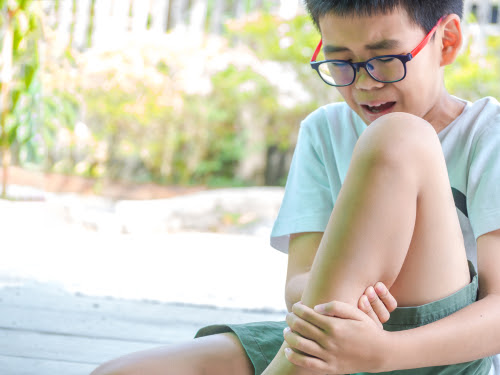Your Child’s Knee Pain: Is There Something More to Check?
A child’s knee pain can be frustrating to you and to them!
Summer is a time when your child is both very active, and often, growing! When knee pain strikes it can be concerning and frustrating if it lingers. Do any of these scenarios sound familiar?
- Your child awakens at night with knee pain. You massage, add some heat, and give some pain reliever. Sometimes it works, and sometimes it doesn’t.
- Your child falls and seems to over-react to the pain at their knee.
- Your child gets up the morning after sports practice or a long day outdoors and merely standing or walking causes extreme pain.
In any of these scenarios, the stress and associated pain can quickly change with Bridging®. Let’s dig in a little more to understand why.
Some interesting tidbits about children’s knees
We often don’t stop to realize that children’s knees are different than adults. Here are some specific attributes about the musculoskeletal aspects of children’s knees which set the stage for knee pain.
- The kneecap bone (patella) forms between age 2 and 6. Prior to this it is only cartilage.
- Two tendons hold the kneecap/cartilage in place.
- Four ligaments connect the muscles groups from the thigh and lower leg to the kneecap/cartilage.
- Bone growth occurs from stress stimulating the growth plates. The bones grow first and then the muscles and connective tissue elongate. The out of sync nature of this can create painful transitions!
- The physics of shorter, thicker bone segments provide more protection against the long legs bones breaking, BUT, put more torque on the connections across the knee.
It’s easy to see why the knee can be so prone to stress!
Common issues with children’s knees
There are many labels to classify the knee stress and pain in children. Here are just a few:
- Osgood Schlatter Disease is a bony growth below the kneecap. We find the knee stress is incorrectly positioned and this causes the bone growth, and the pain. By improving the force transitions across the knee, the pain will diminish.
- Jumpers knee syndrome is pretty much what is sounds like. Stress at the knee from repetitive jumping. The ligaments and muscles are stressed as they adapt to faster growing bones.
- A fracture or dislocation of the kneecap is often stabilized with a cast. Read a recent Blog post about why muscles need a little Bridging® help to remember how to coordinate when a cast is removed. It’s more than getting strength and flexibility back.
- Tears and strains of the connective tissue are also common. Once stable and cleared for activity from your medical professional, Bridging® is able to address the force flows that need to transition better to minimize future stress. For soccer players this is a big deal!
What does Bridging® do to help knees?
The key to helping knee pain is addressing the source of stress. Traditional exercises are used to strengthen adjacent muscles. We find this approach falls short with an active and continuously growing child.
Here are the steps we take from a Bridging® perspective to help with knee stress:
- Understand the cause: Is there stress from a prior injury that impacted correct alignment? Is there a developmental factor with the hip or foot turning in or out that plays a role? Is there a glitch in the way force is absorbed by the body from the feet up through the legs and core that is not flowing well? An x-ray or MRI will not tell you about force dissipation.
- Restore the transitions: We use Bridging®’s gentle stretches and micromovements to reset the muscle groups so the movement transitions flow correctly from foot to knee. By following the sequence of early development, the changes are long lasting, and should adapt with future growth.
- Fine tune to your situational needs: We have you test the way you actually use your legs and knees to address the odd combinations of foot and core positions, which may impact your specific knee stress. The knee stress of a softball catcher compared to a runner compared to a tennis player are totally different.
By taking the time to understand the ‘Why?’ you get a fast solution addressing your specific needs.
Next week … I’ll share some DIY tips for easing knee stress whether an injury or growing pains .

